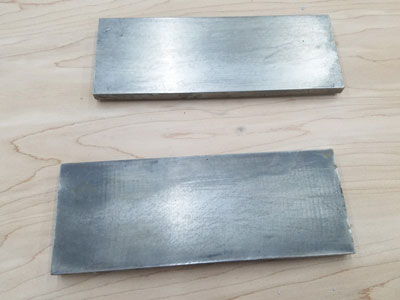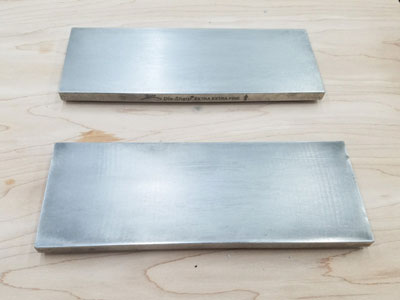|
There is a revolution going on in
tool sharpening
and it is being caused by the new
DMT Dia-Sharp Diamond Stones
. I started woodworking in the early 1990's as a woodcarver so I know the importance of creating a keen edge on a knife, chisel and plane blade. I learned on oil stones, experimented with diamond paste, tried the 'scary sharp' sandpaper method, moved to
waterstones
,
ceramic stones
and recently transitioned to the diamond stones. I know sharpening and I have heard the adage, 'learn a technique and stay with it', which is why I stayed with waterstones for a very long time. However, these diamond stones have made me think differently about sharpening.
First, what are they? I'm not talking about the
DMT Duo-Sharp Stones
that have been on the market for about 20 years, the ones with the plastic base and hole pattern on the surface of the plate. These new plates have a monocrystalline diamond abrasive bonded to the stone's solid surface. This give the plate 30 percent more abrasive for you to use while sharpening. The heavy steel plates are ground flat and DMT says they are guaranteed to stay that way.
The plates come in a variety of sizes but the ones I use measure 8" x 3" x 3/8" thick. They come in 11-1/2" x 2-1/2" x 3/8" as well. The diamond stones can be used wet or dry, but I prefer to lubricate them with soapy water. I also add a derust additive to my water sprayer to prevent the plate from rusting. I'm not sure if this is needed but it can't hurt! In addition, you don't need to soak them in a water bath like you do with waterstones. This simplifies your working area and keeps it a lot cleaner as well!
One extremely important advantage over oil, water and ceramic stones is that they won't chip, crack or dish (hollow) while using them. Since they don't dish, this is a tremendous advantage over both oil and waterstones. There's no need to spend extra time, nor do you need special lapping plates to keep them flat.
Just like other sharpening stones, the plates will clog up with metal sludge but you can easily scrub the surface with scouring powder to unclog and restore the surface. Below is a before and after cleaning picture of the stones:

|

|
The diamond plates are available in four grit levels:
They are nicely labeled along their edges:
Earlier, I said that I believe there is a revolution going on in sharpening because of these stones and that is because of how fast they cut. I learned to hone an edge by hand after creating a hollow-ground bevel on a grinder. This served two purposes, first to quickly remove a lot of material because oil stones didn't cut very fast, and second, you could easily feel when the front and rear edges of the bevel were on the stone. As jigs came along, I started to use them for repeatability. Therefore, the hollow-grind was less critical for stability on the stone, but it still made it easy to remove a lot of metal quickly. These diamond stones have changed all of that. Let's take a look:
Here is a 1 inch chisel that is in pretty rough shape! Prior to using the DMT Diamond Stones, I would've either hollow-gound the bevel on a grinder or spent a lot of time flattening the bevel using lower grit sandpaper. I don't have a coarse plate but below is the bevel after 3 minutes on my
Fine – 600 grit Diamond Stone
.
The 3 minutes included the time to position the chisel in the sharpening jig, register it to the 25-degree angle that I wanted and then lap it on the stone plate. I also spent another 2 minutes flattening the back of the chisel. I assume it would've been faster if I'd had a coarse stone. Even with larger size bevels, there's no need to use a grinder to remove a lot of metal quickly and risk overheating the edge.
Next, I moved the chisel in my jig to create a micro-bevel. I went through my extra-fine stone and then my extra-extra-fine stone, as shown below. This was ten strokes, back and forth, on each stone.
If you look close, there are still very small striations on the surface of the micro-bevel, even when using the extra-extra-fine stone. My observation is that this stone doesn't give you the mirror surface that I can get with a waterstone. Therefore, I'll follow up with a few strokes on my 8000 grit waterstone and then a few strokes on a
leather strop
with compound. This process creates the mirror micro-bevel that I like.
This procedure is also done to the back of the chisel.
The complete operation, from a rough chisel to a nicely tuned edge took me about 8 minutes. This is pretty quick, especially for a larger, 1 inch chisel. This included the time to adjust the jig, change stones, and do both the backside and the bevel of the chisel.
As I've said a couple of times already, these diamond stones are changing how we think about sharpening our blades. Using the diamond stones and leather strops, I'm able to keep an edge sharp for a long time before any serious resharpening is needed in my shop.
I plan on following up this article with a companion article on "New Thoughts on Sharpening." This will include more discussion of the DMT Dia-Sharp Diamond Stones, as well as a discussion on using leather strops to keep a keen edge and eliminate the need to hone on a stone for long periods of time. This will dramatically improve your productivity in the shop.
I highly recommend you take a look at these
DMT Diamond Stones
and consider the advantages compared to your current technique. Once you use one, you won't go back!
Find out more and purchase a
DMT Diamond Stone
Jeffrey Fleisher has been a woodworker for approximately 20 years and a professional woodworker for the past 6 years. He is the president of his local woodturning club, the Woodturners of the Virginias and past president of the Northern Virginia Carvers. You can see some of the furniture he has made at
www.jeffswooddesigns.com
. He can be reached by email at
furnmkr@gmail.com
Return to the
Wood News Online
front page
|